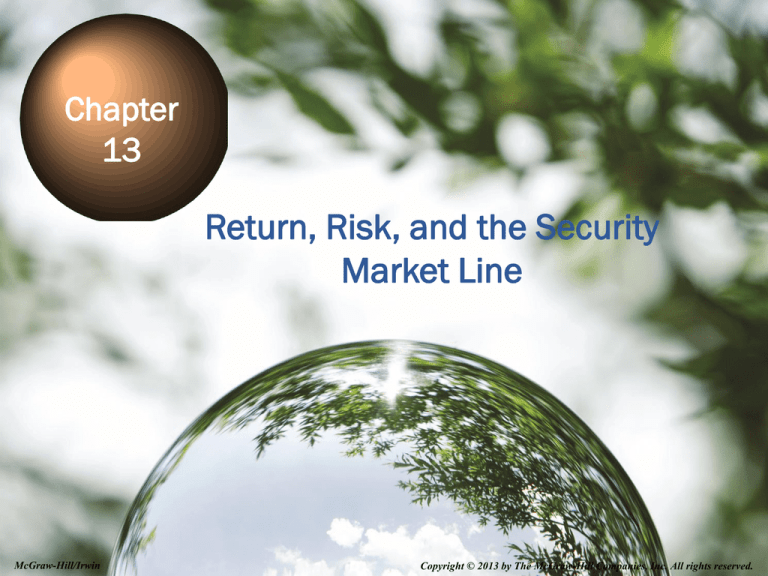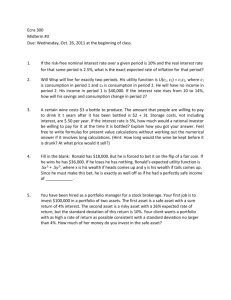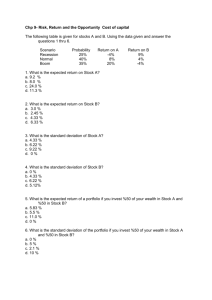
Chapter
13
Return, Risk, and the Security
Market Line
13-1
McGraw-Hill/Irwin
Copyright © 2013 by The McGraw-Hill Companies, Inc. All rights reserved.
Chapter Outline
•Expected Returns and Variances
•Portfolios
•Announcements, Surprises, and Expected Returns
•Risk: Systematic and Unsystematic
•Diversification and Portfolio Risk
•Systematic Risk and Beta
•The Security Market Line
•The SML and the Cost of Capital: A Preview
13-2
Expected Returns
• Expected returns are based on the probabilities
of possible outcomes
• In this context, “expected” means average if the
process is repeated many times
• The “expected” return does not even have to be
a possible return
n
E ( R) pi Ri
i 1
13-3
Example: Expected Returns
Suppose you have predicted the following returns
for stocks C and T in three possible states of the
economy.
1. What is the probability of “Recession”?
State
Probability
Boom
0.3
Normal
0.5
Recession
???
13-4
C
15
10
2
T
25
20
1
Probabilities add up to 100% (or 1.0) thus 1.0 – 0.3 – 0.5
= 0.2 or 20%
Example: Expected Returns
Suppose you have predicted the following returns
for stocks C and T in three possible states of the
economy.
2. What are the expected returns?
State
Probability
Boom
0.3
Normal
0.5
Recession
0.2
C
15
10
2
T
25
20
1
RC = .3(15) + .5(10) + .2(2) = 9.9%
RT = .3(25) + .5(20) + .2(1) = 17.7%
13-5
Variance and Standard
Deviation
•Variance and standard deviation
measure the volatility of returns
•Using unequal probabilities for the
entire range of possible outcomes
•Weighted average of squared deviations
n
σ pi ( Ri E ( R))
2
13-6
i 1
2
Example: Variance and
Standard Deviation
Considering the previous example of
stocks C and T:
State
Probability
Boom
0.3
Normal
0.5
Recession
0.2
Expected return
13-7
C
15
10
2
9.9%
T
25
20
1
17.7%
Example: Variance and
Standard Deviation
1. What is the variance and standard
deviation for C?
13-8
State
Probability
C
T
Boom
0.3
15 25
Normal
0.5
10 20
Recession
0.2
2
1
Expected return
9.9% 17.7%
Stock C
2 = .3(15-9.9)2 + .5(10-9.9)2 + .2(2-9.9)2 =
20.29
= 4.50%
Example: Variance and
Standard Deviation
2. What is the variance and standard
deviation for T?
13-9
State
Probability
C
T
Boom
0.3
15 25
Normal
0.5
10 20
Recession
0.2
2
1
Expected return
9.9% 17.7%
Stock T
2 = .3(25-17.7)2 + .5(20-17.7)2 +
.2(1-17.7)2 = 74.41
= 8.63%
Another Example
Consider the following information:
State
Probability ABC, Inc. (%)
Boom
.25
15
Normal
.50
8
Slowdown
.15
4
Recession
.10
-3
1. What is the expected return?
E(R) = .25(15) + .5(8) + .15(4) + .1(-3)
= 8.05%
13-10
Another Example
Consider the following information:
State
Probability ABC, Inc. (%)
Boom
.25
15
Normal
.50
8
Slowdown
.15
4
Recession
.10
-3
2. What is the variance?
13-11
Variance = σ2= .25(15-8.05)2 + .5(8-8.05)2 +
.15(4-8.05)2 + .1(-3-8.05)2
= 26.7475
Another Example
Consider the following information:
State
Probability ABC, Inc. (%)
Boom
.25
15
Normal
.50
8
Slowdown
.15
4
Recession
.10
-3
3. What is the standard deviation?
Standard Deviation = σ = √ 26.7475
= 5.17%
13-12
Portfolios
•A portfolio is a
collection of assets
•An asset’s risk and
return are important in
how they affect the risk
and return of the
portfolio
13-13
Portfolios
•The risk/return
trade-off for a
portfolio is measured
by the portfolio’s
expected return and
standard deviation,
Risk
just as with individual
assets
13-14
Return
Example: Portfolio Weights
Suppose you have $15,000 to invest
and you have purchased securities
in the following amounts:
$2000 of DCLK
$3000 of KO
$4000 of INTC
$6000 of KEI
13-15
Example: Portfolio Weights
What are your portfolio weights in
each security?
$2,000 of DCLK
$3,000 of KO
$4,000 of INTC
$6,000 of KEI
$15,000
13-16
DCLK:
KO:
INTC:
KEI:
2/15 = .133
3/15 = .200
4/15 = .267
6/15 = .400
15/15 = 1.000
Portfolio Expected Returns
The expected return of a portfolio is the weighted
average of the expected returns of the respective
assets in the portfolio
m
E ( RP ) w j E ( R j )
j 1
You can also find the expected return by finding
the portfolio return in each possible state and
computing the expected value as we did with
individual securities
13-17
Example: Expected Portfolio
Returns
Consider the portfolio weights computed
previously. The individual stocks have the
following expected returns:
DCLK: 19.69%
KO:
5.25%
INTC: 16.65%
KEI:
18.24%
13-18
Example: Expected Portfolio
Returns
1. What is the expected return on this
portfolio?
Return
DCLK: 19.69%
KO:
5.25%
INTC: 16.65%
KEI:
18.24%
Weight
.133
.200
.267
.400
E(RP) = .133(19.69) + .2(5.25) + .267(16.65) + .4(18.24)
= 15.41%
13-19
Portfolio Variance
•Compute the expected portfolio return, the
variance, and the standard deviation using the
same formula as for an individual asset
•Compute the portfolio return for each state:
RP = w1R1 + w2R2 + … + wmRm
13-20
Example: Portfolio Variance
Consider the following information:
State Probability
Boom .4
Bust .6
13-21
A
B
30% -5%
-10% 25%
Example: Portfolio Variance
Consider the following information:
State Probability
Boom .4
Bust .6
A
B
30% -5%
-10% 25%
1. What is the expected return for
asset A?
Asset A: E(RA) = .4(30) + .6(-10) = 6%
13-22
Example: Portfolio Variance
Consider the following information:
State Probability
Boom .4
Bust .6
A
B
30% -5%
-10% 25%
2. What is the variance for asset A?
Variance(A) = .4(30-6)2 + .6(-10-6)2
= 384
13-23
Example: Portfolio Variance
Consider the following information:
State Probability
Boom .4
Bust .6
A
B
30% -5%
-10% 25%
3. What is the standard deviation for
asset A?
Std. Dev.(A) = 19.6%
13-24
Example: Portfolio Variance
Consider the following information:
State Probability
Boom .4
Bust .6
A
B
30% -5%
-10% 25%
4. What is the expected return for
asset B?
E(RB) = .4(-5) + .6(25) = 13%
13-25
Example: Portfolio Variance
Consider the following information:
State Probability
Boom .4
Bust .6
A
B
30% -5%
-10% 25%
5. What is the variance for asset B?
Variance(B) = .4(-5-13)2 + .6(25-13)2
= 216
13-26
Example: Portfolio Variance
Consider the following information:
State Probability
Boom .4
Bust .6
A
B
30% -5%
-10% 25%
6. What is the standard deviation for
asset B?
Std. Dev.(B) = 14.7%
13-27
Example: Portfolio Variance
Consider the following information:
State Probability
Boom .4
Bust .6
A
B
30% -5%
-10% 25%
7. If you invest 50% of your money in Asset A,
what is the expected return for the portfolio
in each state of the economy?
If 50% of the investment is in Asset A, then
50% (100% - 50%) must be invested in Asset
B as the total asset allocation must be 100%
13-28
Example: Portfolio Variance
Consider the following information:
State Probability
Boom .4
Bust .6
A
B
30% -5%
-10% 25%
8. If you invest 50% of your money in Asset A,
what is the expected return for the portfolio
in a boom period?
Portfolio return in boom = .5(30) + .5(-5)
= 12.5%
13-29
Example: Portfolio Variance
Consider the following information:
State Probability
Boom .4
Bust .6
A
B
30% -5%
-10% 25%
9. What is the expected return for the portfolio
as a whole (considering both states of the
economy)?
13-30
Exp. portfolio return = .4(12.5) + .6(7.5)
= 9.5%
Or Exp. portfolio return = .5(6) + .5(13)
= 9.5%
Example: Portfolio Variance
Consider the following information:
State Probability
Boom .4
Bust .6
A
B
30% -5%
-10% 25%
10. What is the variance of the portfolio?
Variance of portfolio =
.4(12.5-9.5)2 + .6(7.5-9.5)2
=6
13-31
Example: Portfolio Variance
Consider the following information:
State Probability
Boom .4
Bust .6
A
B
30% -5%
-10% 25%
11. What is the standard deviation of the
portfolio?
Standard deviation = 2.45%
13-32
Another Example
Consider the following information:
State
Probability
Boom
.25
Normal
.60
Recession
.15
X
15%
10%
5%
Z
10%
9%
10%
What are the expected return and standard
deviation for a portfolio with an
investment of $6,000 in asset X and $4,000 in
asset Z?
13-33
Systematic Risk
•Risk factors that affect a
large number of assets
•Also known as nondiversifiable risk or
market risk
•Includes such things as
changes in GDP, inflation,
interest rates, etc.
13-34
Unsystematic Risk
•Risk factors that affect a limited
number of assets
•Also known as unique risk and
asset-specific risk
•Includes such things as labor
strikes, part shortages, etc.
13-35
Diversification
•Portfolio diversification is the investment in
several different asset classes or sectors
•Diversification is not just holding a lot of assets
13-36
Diversification
•For example, if you
own 5 airline stocks,
you are not diversified
•However, if you own 50
stocks that span 20
different industries,
then you are
diversified
13-37
Total Risk
•Total risk = systematic risk + unsystematic risk
•The standard deviation of returns is a measure
of total risk
•For well-diversified portfolios, unsystematic
risk is very small
•Consequently, the total risk for a diversified
portfolio is essentially equivalent to just the
systematic risk
13-38
13-39
The Principle of Diversification
• Diversification can substantially reduce the
variability of returns without an equivalent
reduction in expected returns
• This reduction in risk arises because worse-thanexpected returns from one asset are offset by betterthan-expected returns from another
• However, there is a minimum level of risk that
cannot be diversified away and that is the systematic
portion
13-40
Measuring Systematic Risk
How do we measure systematic risk?
We use the beta coefficient
What does beta tell us?
13-41
•
A beta of 1 implies the asset has the same
systematic risk as the overall market
•
A beta < 1 implies the asset has less
systematic risk than the overall market
•
A beta > 1 implies the asset has more
systematic risk than the overall market
Actual Company Betas
13-42
Work the Web Example
•Many sites provide betas for companies
•Yahoo Finance provides beta, plus a lot of
other information under its Key Statistics link
•Click on the web surfer to go to Yahoo
Finance
•Enter a ticker symbol and get a basic quote
•Click on Key Statistics
13-43
Total vs. Systematic Risk
Consider the following information:
Standard Deviation
Security C
20%
Security K
30%
Beta
1.25
0.95
1. Which security has more total risk?
K because the standard deviation
is greater than C
2. Which security has more systematic risk?
C because the beta is larger than K
13-44
Total vs. Systematic Risk
Consider the following information:
Standard Deviation
Security C
20%
Security K
30%
Beta
1.25
0.95
3. Which security should have the higher
expected return?
C because beta measures risk and it’s
expected return
13-45
Example: Portfolio Betas
Consider the previous example with the following
four securities:
Security
DCLK
KO
INTC
KEI
WeightBeta
.133
.2
.267
.4
2.685
0.195
2.161
2.434
What is the portfolio beta?
13-46
.133(2.685) + .2(.195) + .267(2.161) + .4(2.434)
= 1.947
Beta and the Risk Premium
Remember that the risk premium =
expected return – risk-free rate
The higher the beta, the greater the risk
premium should be
Can we define the relationship between the
risk premium and beta so that we can
estimate the expected return?
13-47
YES!
Example: Portfolio Expected
Returns and Betas: The SML
E(RA)
Rf
13-48
A
Security Market Line
•The security market line (SML) is the representation
of market equilibrium
•The slope of the SML is the reward-to-risk ratio:
(E(RM) – Rf) / M
•But since the beta for the market is ALWAYS equal to
one, the slope can be rewritten:
Slope = E(RM) – Rf = market risk premium
13-49
Reward-to-Risk Ratio:
Definition and Example
•The reward-to-risk ratio is the slope of the line
illustrated in the previous example
•Slope = (E(RA) – Rf) / (A – 0)
•Reward-to-risk ratio for previous example =
(20 – 8) / (1.6 – 0) = 7.5
•What if an asset has a reward-to-risk ratio of 8
(implying that the asset plots above the line)?
•What if an asset has a reward-to-risk ratio of 7
(implying that the asset plots below the line)?
13-50
Market Equilibrium
In equilibrium, all assets and portfolios
must have the same reward-to-risk ratio,
and they all must equal the reward-torisk ratio for the market
E ( RA ) R f
A
13-51
E ( RM R f )
M
The Capital Asset Pricing
Model (CAPM)
The capital asset pricing model defines
the relationship between risk and return:
E(RA) = Rf + A(E(RM) – Rf)
If we know an asset’s systematic risk, we can use
the CAPM to determine its expected return
This is true whether we are talking about
financial assets or physical assets
13-52
Example - CAPM
Consider the betas for each of the assets given
earlier. If the risk-free rate is 4.15% and the market
risk premium is 8.5%,
What is the expected return for each?
Security
13-53
Beta
Expected Return
DCLK
2.685
4.15 + 2.685(8.5) = 26.97%
KO
0.195
4.15 + 0.195(8.5) = 5.81%
INTC
2.161
4.15 + 2.161(8.5) = 22.52%
KEI
2.434
4.15 + 2.434(8.5) = 24.84%
The CAPM
13-54
Quick Quiz
How do you compute the expected return and
standard deviation for an individual asset? For a
portfolio?
What is the difference between systematic and
unsystematic risk?
What type of risk is relevant for determining the
expected return?
Consider an asset with a beta of 1.2, a risk-free
rate of 5%, and a market return of 13%.
13-55
What is the reward-to-risk ratio in equilibrium?
What is the expected return on the asset?
Comprehensive Problem
1. The risk free rate is 4%, and the required return
on the market is 12%. What is the required return
on an asset with a beta of 1.5?
2. What is the reward/risk ratio?
3. What is the required return on a portfolio
consisting of 40% of the asset above and the rest
in an asset with an average amount of systematic
risk?
13-56
Terminology
•Portfolio
•Expected Return
•Unsystematic Risk
•Systematic Risk
•Security Market Line (SML)
•Beta
•Capital Asset Pricing Model (CAPM)
13-57
Formulas
n
E ( R) pi Ri Expected return on an
i 1
investment
n
σ pi ( Ri E ( R))
2
i 1
m
2
Variance of an entire
population, not a sample
E ( RP ) w j E ( R j )
j 1
13-58
Expected return on a
portfolio
Formulas
E ( RA ) R f
A
E ( RM R f )
M
Slope = E(RM) – Rf = market risk premium
CAPM = E(RA) = Rf + A(E(RM) – Rf)
13-59






